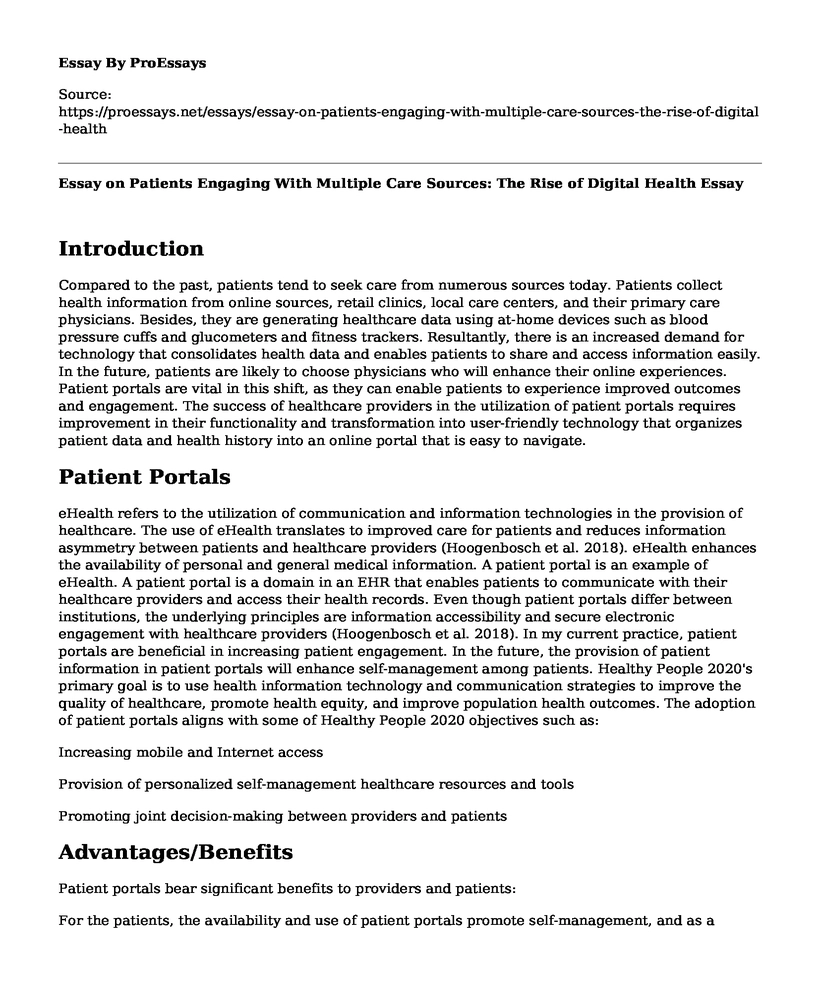Introduction
Compared to the past, patients tend to seek care from numerous sources today. Patients collect health information from online sources, retail clinics, local care centers, and their primary care physicians. Besides, they are generating healthcare data using at-home devices such as blood pressure cuffs and glucometers and fitness trackers. Resultantly, there is an increased demand for technology that consolidates health data and enables patients to share and access information easily. In the future, patients are likely to choose physicians who will enhance their online experiences. Patient portals are vital in this shift, as they can enable patients to experience improved outcomes and engagement. The success of healthcare providers in the utilization of patient portals requires improvement in their functionality and transformation into user-friendly technology that organizes patient data and health history into an online portal that is easy to navigate.
Patient Portals
eHealth refers to the utilization of communication and information technologies in the provision of healthcare. The use of eHealth translates to improved care for patients and reduces information asymmetry between patients and healthcare providers (Hoogenbosch et al. 2018). eHealth enhances the availability of personal and general medical information. A patient portal is an example of eHealth. A patient portal is a domain in an EHR that enables patients to communicate with their healthcare providers and access their health records. Even though patient portals differ between institutions, the underlying principles are information accessibility and secure electronic engagement with healthcare providers (Hoogenbosch et al. 2018). In my current practice, patient portals are beneficial in increasing patient engagement. In the future, the provision of patient information in patient portals will enhance self-management among patients. Healthy People 2020's primary goal is to use health information technology and communication strategies to improve the quality of healthcare, promote health equity, and improve population health outcomes. The adoption of patient portals aligns with some of Healthy People 2020 objectives such as:
Increasing mobile and Internet access
Provision of personalized self-management healthcare resources and tools
Promoting joint decision-making between providers and patients
Advantages/Benefits
Patient portals bear significant benefits to providers and patients:
For the patients, the availability and use of patient portals promote self-management, and as a result, increased satisfaction (Hoogenbosch et al. 2018). Patients can have access to their health information and engagement with care providers, enabling them to identify their options of care and prevention measures.
On the other side, nurses benefit from the engagement of patients in patient portals through access to more information that is crucial in the identification of health issues and the choice of treatment methods. Due to this increased information, there are improved patient outcomes and satisfaction among nurses.
Disadvantages/Barriers
One major disadvantage of the increased adoption of patient portals is lower health consumption. Some patients may use patient portals as a replacement for usual care, which could result in underutilization and misdiagnoses (Miller et al. 2016). Another barrier is that technology use is limited to a particular class of people who possess the ability to interact with digital devices. As such, this technology cannot cover the entire population as required.
On the other hand, nurses argue that the use of patient portals could confuse patients, increasing calls to the clinic (Miller et al. 2016). This problem is solvable through the provision of clear information and increased interaction with providers on the portal. Besides, there are concerns that patient portals might not affect the reduction of workload among nurses, due to the low usage among certain groups of patients.
Application to Practice Area
Patient portals are easy to adopt, as they will utilize the available patient data in health databases. As such, there is no need for other equipment, which makes it easy to embrace. Healthcare institutions need to add a portal on their website where patients can sign up for free and create their profiles. Full implementation can take up to 3 years of the creation of awareness and demonstration of benefits.
References
Hoogenbosch, B., Postma, J., Janneke, M., Tiemessen, N. A., van Delden, J. J., & van Os-Medendorp, H. (2018). Use and the users of a patient portal: Cross-sectional study. Journal of medical Internet research, 20(9), e262.
Miller Jr, D. P., Latulipe, C., Melius, K. A., Quandt, S. A., & Arcury, T. A. (2016). Primary care providers' views of patient portals: interview study of perceived benefits and consequences. Journal of medical Internet research, 18(1), e8.
Cite this page
Essay on Patients Engaging With Multiple Care Sources: The Rise of Digital Health. (2023, Mar 26). Retrieved from https://proessays.net/essays/essay-on-patients-engaging-with-multiple-care-sources-the-rise-of-digital-health
If you are the original author of this essay and no longer wish to have it published on the ProEssays website, please click below to request its removal:
- Course Work Example: Social Work with Volunteer Family
- Paper Example on Person-Centered Care
- Expanding on Explanation of Domestic Radon Exposure and Risk of Childhood Cancer Article
- Essay Sample on Data-Driven Population Wellbeing: A Comprehensive Look
- Paper Example on Unravelling the Pathophysiologya of Onychomycosis
- Essay on Vitamin D: Essential for Healthy Bones, May Reduce Autism Risk in Children
- EHRs vs Survey Data in Health Care: Quality Measurements - Essay Sample







